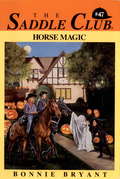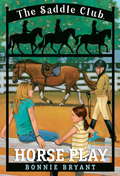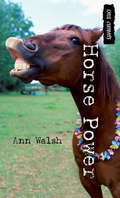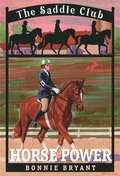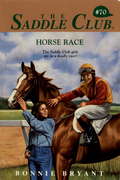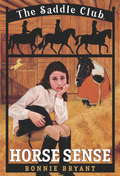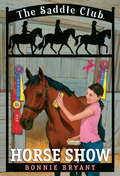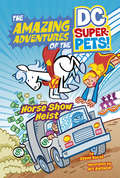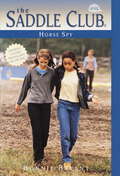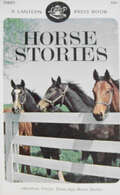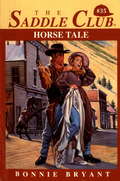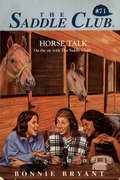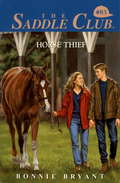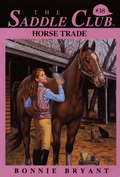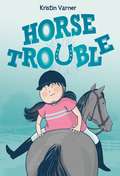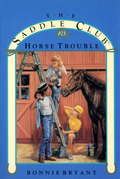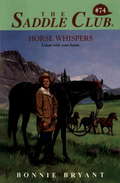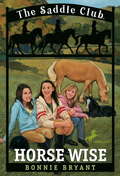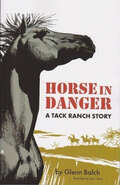- Table View
- List View
Horse Love (Saddle Club #93)
by Bonnie BryantLisa Atwood and her family are on vacation, but it isn't all fun in the sun. Something's wrong between her parents. She thinks it's serious, and she's worried. Then a handsome guy sweeps Lisa off her feet and all of her problems seem to melt away.
Horse Magic (Saddle Club #47)
by Bonnie BryantIt's Halloween, and Pine Hollow Stables is getting some special visitors--a group of city kids. The Saddle Club girls are planning a treasure hunt and trick-or-treating for the children. Best of all, Stevie Lake's old school chum, Dinah, has come to help. Stevie can't wait to pull some pranks on her friend!Things go awry when it becomes clear that Dinah and Saddle Club member Lisa Atwood don't like each other. Lisa suspects Dinah of flirting with Stevie's boyfriend. Even worse, Stevie's beginning to think the stable is haunted. Who's playing tricks at Pine Hollow?
Horse Play (Horse Crazy #5)
by Virginia Vail Daniel BodeThirteen-year-old Emily and her fellow campers at Webster's Country Horse Camp fear that the owner plans to sell his land to a real estate developer, so they stretch the truth a bit in trying to convince the developer of imaginary hazards on the property. Picture descriptions present.
Horse Play (Saddle Club #7)
by Bonnie BryantTHE SADDLE CLUB would do anything to help a friend in need. So when Stevie overhears Max on the phone mysteriously pleading for more time and more money, she, Lisa, and Carole, know what they need to do. Pine Hollow is clearly in trouble and it's up to the Saddle Club to save the day. But while the girls are plotting good deeds, someone is pulling pranks on them! Could it be the same person who wants to see Pine Hollow sold to the highest bidder?
Horse Power (Orca Currents)
by Ann WalshOnce again Callie is forced to take part in her mom's latest crusade. They head into ranch country to camp -- bloodthirsty mosquitoes, stinky outhouses and all -- at a protest to save a rural school. Callie's grandmother shows up with her biker buddies and the singing grannies. Callie hates camping and wants nothing to do with the protest. To make matters worse, Callie's only possible ally, her cousin Del, is mad at her. The last time Callie visited, she was thrown from Del's horse, Radish. Callie claimed the horse was vicious and now Del's parents are forcing her to sell Radish. Callie wants to help her cousin, but she's terrified of the horse. Del is just as tenacious as the rest of Callie's family, and Callie is forced to admit that she's not going to be allowed to go home until both the horse and the school are saved.
Horse Power (Saddle Club #4)
by Bonnie BryantCarole, Stevie, and Lisa have been looking for a fourth member to join the Saddle Club. So when Carole introduces her friends to Kate Devine, the championship rider, the girls know they've found the perfect fit. Except that Kate doesn't want to ride ever again. . . .
Horse Race (Saddle Club #70)
by Bonnie BryantStevie, Carole, and Lisa are going back to the racetrack. Then the girls spot an official in the wrong place taking money from someone he shouldn't. The official sees the girls and knows they're on to him! Now the girls are in danger.
Horse Sense (Saddle Club #3)
by Bonnie BryantLisa love being a member of the Saddle Club. But lately, Stevie and Carole haven't had time for her or their friendship. And if she can'tconvince her friends that their club is just as important, she may have to find new members to replace them. . . .
Horse Sense: The Story of Will Sasse, His Horse Star, and the Outlaw Jesse James
by Janet Neubert SchultzWill Sasse is sick of his pa's slow, careful ways. Pa says only sturdy workhorses are worth raising out in farm country. Will wants to raise beautiful pleasure horses like his mare, Star. So what if it's a risk? Will wishes Pa was more like Jesse, a daring new friend. When Will is caught in a bloody shootout and a fatally botched bank robbery, he realizes that his friend is really the outlaw Jesse James. The James Gang is escaping—and they're taking Star with them. Will joins a posse in pursuit of the outlaws. As the posse closes in, Will realizes that he must make a choice—what kind of life does he really want?
Horse Show (Saddle Club #8)
by Bonnie BryantTO THE SADDLE Club, there's nothing more exciting than riding horses at Pine Hollow - until they're invited to New York City to watch the American Horse Show! Max's former student, Dorothy DeSoto, will be competing, and the girls will get a backstage view of competitive riding. And in their free time, Lisa, Carole, and Stevie might just get to be the star of their own show - on the big screen!
Horse Show Heist (The Amazing Adventures of the DC Super-Pets)
by Steve KorteWhen Supergirl and her super-horse, Comet, enter a horse show, thieves show up to ruin the day. Can the super-pair win the gold, stop the bad guys, and keep Supergirl’s identity a secret?
Horse Shy (Saddle Club #2)
by Bonnie BryantWhen one of Pine Hollow's students makes a terrible mistake, causing a tragic accident, Carole is done with riding forever. Unless Stevie and Lisa can remind her what friendship and the Saddle Club are all about.
Horse Spy (Saddle Club #94)
by Bonnie BryantThe President and his horse-crazy daughter will be visiting Washington. Carole invites the girl to come for a ride at Pine Hollow. Security men walk around Pine Hollow, asking for security clearance for horses. But what happens when a real spy turns up?
Horse Stories
by David ThomasEditor David Thomas has selected over a dozen stories for those who love horses. Some of the stories are set in wild country, some in small towns, some in cities. There’s the wild black stallion no man had ever been able to tame, and Two-bits, the policeman’s horse who helped catch a criminal. There’s Torchy, the pony Mary wanted so badly— except that she didn’t have the ten dollars needed to buy him. There’s Ba-ee, the orphan colt found by a crippled Indian boy—and Nemmy, the most difficult horse in Battery B. Written by famous authors such as Jim Kjelgaard, Irving Crump, Harry Sinclair Drago, Kathryn Cook, and Matt Armstrong, among others, these exciting stories will bring a tear to your eyes, a lump to your throat, and joy to your heart.
Horse Stories (Basic Vocabulary)
by Marguerite P. Dolch Edward W. DolchThe books in the Basic Vocabulary Series are written with charm of style and high interest appeal for the children. Children love to read them for fun and thus get a vast amount of practice in reading skills. A high literary quality has been maintained in writing these true stories of animals, and retelling tales of folklore.
Horse Tale (Saddle Club #35)
by Bonnie BryantStevie has always longed for a horse of her own, and this summer she finally has the chance to get one.
Horse Talk (Saddle Club #71)
by Bonnie BryantWillow Creek Junior High School gets its own radio station and Saddle club hosts a call-in show. Initially nobody calls, then Stevie's brother's friends call asking silly questions. A caller then tells about a horse in trouble. Is the call for real?
Horse Thief
by Robert Newton PeckAfter losing two fingers in his first bull ride, seventeen-year-old Tullis Yoder worries he'll never have a chance to top another bull. Then the rodeo show he works for goes broke, and he learns that its thirteen horses, his only family, will be slaughtered for dog meat. With the help of a lady doctor and an aging professional horse thief, Tullis steals his beloved horses. He wants to set the horses free, but with crooks, three sheriffs, and a powerful judge after him, will he have a chance?
Horse Thief (Saddle Club #83)
by Bonnie BryantThe Saddle Club is taking part in a big Pony Club rally being held at Pine Hollow. Riders from all the local Pony Clubs are there, including Stevie's boyfriend, Phil Marsten. For once Stevie and Phil aren't being too competitive so everyone is having a good time--until a thief spoils the fun by stealing $500 from the stable office. Veronica diAngelo says she saw Phil hanging around the office and acting suspiciously. And Phil did need money. But he'd never resort to theft, would he? Is Veronica up to something? Or is there a thief among the riders? It's up to the Saddle Club to find out and clear Phil's name.
Horse Trade (Saddle Club #38)
by Bonnie BryantStevie accepts her boyfriend Phil's offer to ride the Arabian. She promises to provide the beautiful horse with the best of care and is alarmed by a mysterious allergy that develops.
Horse Trouble
by Kristin VarnerAn American Library Association 2021 Best Graphic Novel for ChildrenTwelve-year-old Kate is laser-focused on her one true passion: horseback riding. But try as she might, she can't hide from life's problems in the stable.There's nothing Kate loves more than being around horses. But her best friend is allergic to them, so Kate has to take riding lessons without her. Kate's forced to navigate some of life's hardships—like the mean girls at the stable who tease her and her body insecurities—all on her own. To make matters worse, Kate is continually falling off her horse. To Kate, her tween years feel like one unfair punishment after another. Can she get over it all…and get back on her horse?Horse Trouble, the debut graphic novel from children's book artist Kristin Varner, is an oh-so-relatable graphic novel with humor and heart.
Horse Trouble (Saddle Club #23)
by Bonnie BryantWhen Mrs. Reg, the manager of Pine Hollow Stables, goes away for a few days, The Saddle Club is determined to pitch in and keep things running smoothly. Lisa, Carole, and Stevie decide they know everything there is to know about horses, so they'll have no problem managing a stable for a few days...right? Wrong! instead it seems that every time the girls try to help, disaster quickly follows. More paint winds up on one of the horses than on the stable; several riders don't get quite the ride they expect; and Mrs. Reg's paperwork is in utter chaos. Soon the members of The Saddle Club are wondering if being horse crazy is all they need to manage the stable, after all!
Horse Whispers (Saddle Club #74)
by Bonnie BryantThe Saddle Club finds her running with a herd of wild horses that lives on the Bar None land. They bring the mare back. She runs away again. They bring her back again, only to have her run away once more.
Horse Wise (Saddle Club #11)
by Bonnie BryantWHEN MAX ANNOUNCES that Pine Hollow will begin its own Pony Club, Stevie, Carole, and Lisa are excited to know they're about to become even more knowledgeable about horses. But spoiled Veronica is more focused on riding her new horse than learning how to take care of him. The Saddle Club won't soon forget what happened with Veronica's last horse, Cobalt. And when it looks like she's headed for the same trouble again, the girls are quick to act--but are they already too late?
Horse in Danger: A Tack Ranch Story (Tack Ranch #7)
by Glenn BalchTwo men from nearby Bar-B rode in to Tack Ranch in an angry mood. They accused King, the black stallion, of raiding their brood mares. And, if Vince Darby didn't do something about it-since King carried his brand-they'd have to shoot. King was the leader of the largest band of wild horses that roamed the wild and rugged Twin Buttes country. He was more than just a horse to Ben and Dixie Darby and to Gaucho, the Argentine trainer who had such a way with horses. King was a leader and a fine herd sire, so they had to prove, if possible, that he had not raided the ranchers' herds. What happens in the big rugged ranch country of Idaho and Nevada when these three Tack riders start out to look for the missing colts makes a fast-moving and exciting mystery, written with the same fine understanding for horses that all of the many readers of Glenn Balch's books have come to expect.

